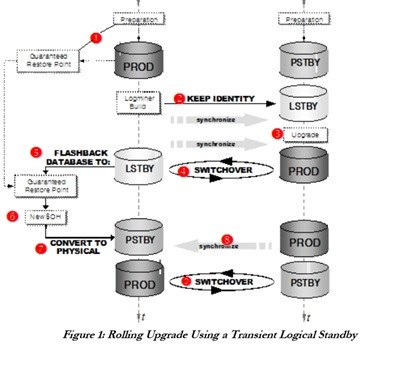Rolling Patch Oracle Data Guard


Dec 08, 2015 Few concerns for this patch: This patch is not Oracle RAC Rolling installable. This patch is not Data Guard Standby First Installable. This patch requires. Simple Database Upgrades with 12c. It comes with Oracle Active Data Guard feature. In this article I will try to focus your attention on 'How to apply a patch.
5. White City Game Full Version. 1 Options for High Availability Oracle has a Maximum Availability Architecture (MAA), which includes a combination of the options with Data Guard and RAC environments. With RAC, you can apply rolling patches to eliminate downtime for patching. Additional nodes can be added to the cluster to provide more resources, since the nodes can use the CPUs and memory that are available on each server. Data Guard also provides a way to test an application rollout or database upgrade by using a snapshot of production database on the standby server.
ASM, when used in the RAC environment, is part of a high-availability solution. ASM manages the disks available to databases and instances on a server. It simplifies the management of Oracle database files and provides a clustered file system. Replication and Oracle Streams might not be considered part of a high availability solution for Oracle because RAC and Data Guard can provide the maximum availability without having to manage the replication processes.
Including backups and flashback, further reduces the risks for unplanned failures and planned maintenance. 5.2 Clustering with RAC Clustering is ideal for two or more servers that have shared resources, such as disks.
In case of a hardware failure on one server in the cluster, the other servers can pick up the workload until that server can be brought back up. Oracle RAC servers share a disk and have the same Oracle database but with different instances running on each node. If one node fails, the connections failover to the other node. The instances do not failover, because the instances are just the processes on each server that access the same data. The Oracle database is available from any of the nodes in the cluster.
The advantage of Oracle RAC is that the resources on both nodes are used by the database, and each node uses its own memory and CPU. Information is shared between nodes through the interconnect—the virtual private network. RAC provides high availability because of the failover of connections in the event of a hardware failure or server connection failure. The RAC environment also provides high availability for patching with rolling upgrades (Oracle Database 11g).
And you can easily add a new server with memory and CPU to the cluster, make new connections to the new node, and the workload will be rebalanced between all of the nodes. • Configuring RAC Configuring an RAC environment starts off similar to setting up a cluster of servers in a SQL Server environment.
The servers need to have a private network between the machines and a set of disks that can be seen by all of the servers in the cluster. The disks will need space for the Oracle Cluster Registry (OCR) and voting disk, just as a SQL Server cluster needs a quorum disk for the cluster membership. After the network configuration and disk allocation, the Oracle Clusterware software can be installed.